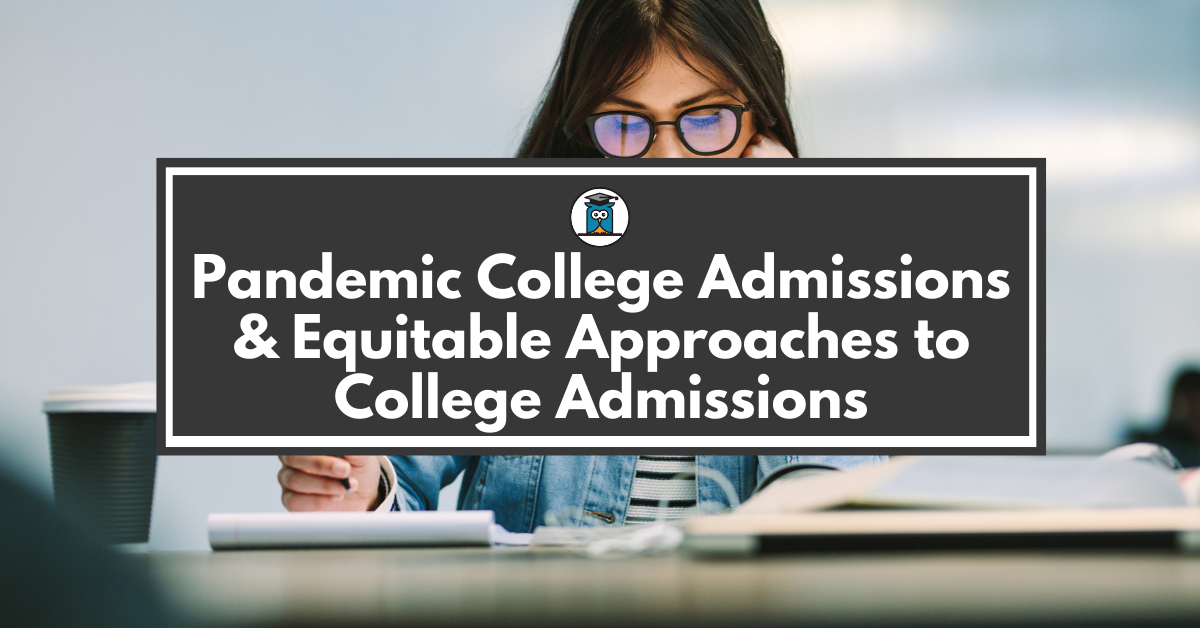By Karly B., MPP Tutor
Test-optional or test-blind? These two terms appear frequently in discussions surrounding college admissions during the pandemic. What’s the difference between them and what are the implications for college applicants this year? Both test-optional and test-blind practices have become increasingly used in recent years to make admissions processes more equitable. Research suggests that college aptitude tests are heavily socioeconomically and racially biased (Elsesser, 2019). This practically means that college aptitude tests, like the ACT and SAT, tend to advantage students from affluent, White communities compared with students from other backgrounds. Other research on Covid-19 suggests that the pandemic also impacts people of color and low-income earners at disproportionate rates (Albert Henry, 2020). When compounding these two inequalities, it seems like already biased standardized tests might perpetuate socioeconomic and racial admissions inequities at unprecedented rates during this pandemic.
To combat this inequity, many colleges are turning toward test-optional and test-blind admissions policies. Test-optional and test-blind policies maintain distinct pros and cons for test-takers. Below are some pros and cons to consider when applying to a test-optional and or test-blind college during the pandemic:
Test-optional admissions
Pros: Several colleges already use this approach outside of the pandemic, meaning that there’s an established standard for schools looking to implement test-optional policies (Niche, 2020). Arguments for test-optional admission generally emphasize the idea that high school record better predicts college performance than SAT and ACT scores. Test-optional policies give students more autonomy to choose whether their test scores may hurt or help them, so students who score well can use those scores to help them while students who fall short of expectations are not penalized. Such policies also allow students who don’t have access to standardized tests to be considered for admission.
Cons: Making tests optional does have the ability to eliminate some of the socioeconomic and racial biases associated with standardized tests, but these policies present other equity-related challenges. At some private institutions, we see schools eliminating need-blind admissions policies when they go test-optional (Jump, 2020). This is to say, when colleges take away test requirements, some schools start looking at other means like parent occupation to discriminate who can afford the education.
Subjective measures like interviews and essays also tend to become more heavily weighted at test-optional private institutions. This raises potential concerns for increased legacy and other discriminatory admissions processes that tend to favor affluent, White students. Under most test-optional policies, no one can measure whether a student interviews “well”. This gives admission offices significant leeway to use such practices to justify admitting the students that can afford to attend with scholarships or aid.
Test-optional policies also do not guarantee that students don’t need to report scores. At some test-optional institutions, test scores are still required to apply for many scholarships (USC Experts, 2020).
I attended a test-optional private college where discussions surrounding the weight on essays and interviews in the college admissions process were common. In my own admissions interview, I remember being thrown off by the question, “So tell me about your parents. What do they do?”. If more institutions start adopting test-optional policies during the pandemic, it’s possible that we might start to see more questions like this appearing in interviews. If this happens, colleges may end up reinforcing the very biases they seek to prevent through making tests optional.
Test-Blind Policies
Pros: With a test-blind policy, colleges do not consider standardized test scores for any students during the admissions process. This practically means that students don’t need to worry about their test scores for admissions or scholarships. Overall, test-blind policies feel more equitable than test-optional. Test-blind policies present all the advantages associated with test-optional ones, and they go a step further by ensuring that test scores presented by some students don’t harm others who choose not to submit.
Practical example: Say that Kiera and Kyndall are applying to a college. They are from the same area, attended the same high school, and took the same classes. On paper, they are exactly the same, but Kiera submits her SAT scores and Kyndall does not. We do not know Kyndall’s test scores, but we know that Kiera’s were strong. Under a test-optional policy, Kiera might be admitted over Kyndall since her test scores aided her application. With a test-blind policy, their chances for admission remain equal.
Cons: While test-blind policies demonstrate more potential for equity than test-optional ones, significant problems still persist with these models. Under test-blind policies, if a student performs well on a standardized test, that score will not help them. This can be frustrating for students who earn high scores, and it forfeits that datapoint for colleges to holistically assess the student’s aptitude. Just as a student might not perform well on the SAT or ACT, another student might have performed poorly during one semester of high school for personal reasons (like reasons associated with Covid-19). A test-blind policy does not allow admissions committees to use strong test scores to account for the student’s lapse in academic performance.
Much like test-optional policies, test-blind policies also leave room for emphasis on subjective admissions criteria like interviews and essays. In this sense, both policies fail to standardize admissions in a way that hold admissions committees accountable for the students they admit.
Takeaways for Students
Admissions committees must weigh the pros and cons for both policies this cycle, and their decisions will likely vary with no clear standard “best” option. Potential test-optional and test-blind policies can give students some comfort this cycle, especially if they don’t meet their standardized test performance goals. Still, given the large variance we can expect to see in admissions practices, students should still prepare for standardized tests. Private companies like My Private Professor, based in Orange County, California, are expanding online tutoring access to help students prepare for the ACT and SAT remotely. By taking advantages of these online resources, students can ensure that they are fully prepared to apply this cycle, regardless of individual admissions committee decisions.
If you have any questions regarding the College Admissions process, attend My Private Professor’s “VIP Pass to College Apps” webinar on Tuesday, August 3rd at 7pm PST. There will be a Harvard-trained college admissions expert who will be answering all your questions about college admissions at no cost to you! Sign up for our webinar here.
Karly B. is a tutor at My Private Professor, which provides individualized online & in-person tutoring to students in all subjects, including K-12 math, science, language arts, history, foreign language, AP exams, test prep, essays, & college counseling, by top tutors from top universities. www.myprivateprofessor.com







